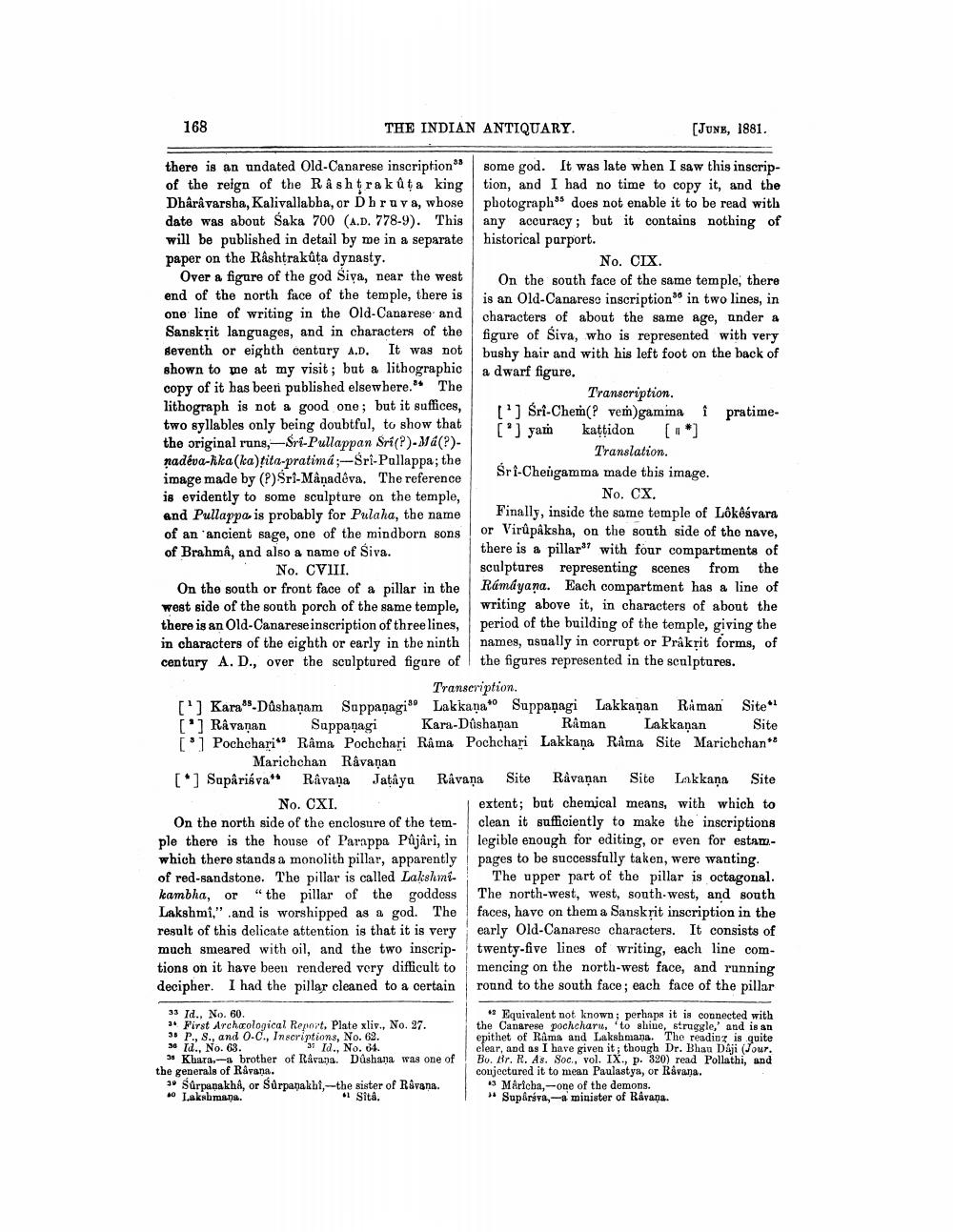________________
168
THE INDIAN ANTIQUARY.
there is an undated Old-Canarese inscription of the reign of the Rashtrakuta king Dhârâvarsha, Kalivallabha, or Dhruv a, whose date was about Saka 700 (A.D. 778-9). This will be published in detail by me in a separate paper on the Rashtrakuta dynasty.
Over a figure of the god Siva, near the west end of the north face of the temple, there is one line of writing in the Old-Canarese and Sanskrit languages, and in characters of the seventh or eighth century A.D. It was not shown to me at my visit; but a lithographic copy of it has been published elsewhere." The lithograph is not a good one; but it suffices, two syllables only being doubtful, to show that the original runs, Sri-Pullappan Sri(?)-Má(?)nadeva-hka (ka)tita-pratimá;-Sri-Pallappa; the image made by (P) Sri-Manadêva. The reference is evidently to some sculpture on the temple, and Pullappa is probably for Pulaha, the name of an ancient sage, one of the mindborn sons of Brahmâ, and also a name of Siva.
No. CVIII.
On the south or front face of a pillar in the west side of the south porch of the same temple, there is an Old-Canarese inscription of three lines, in characters of the eighth or early in the ninth century A. D., over the sculptured figure of
[JUNE, 1881.
some god. It was late when I saw this inscription, and I had no time to copy it, and the photographs does not enable it to be read with any accuracy; but it contains nothing of historical purport.
No. CIX.
On the south face of the same temple, there is an Old-Canarese inscription in two lines, in characters of about the same age, under a figure of Siva, who is represented with very bushy hair and with his left foot on the back of a dwarf figure.
Finally, inside the same temple of Lôkêśvara or Virupaksha, on the south side of the nave, there is a pillar with four compartments of sculptures representing scenes from the Ramayana. Each compartment has a line of writing above it, in characters of about the period of the building of the temple, giving the names, usually in corrupt or Prakrit forms, of the figures represented in the sculptures. Transcription.
[1] Kara-Dushanam Suppanagi Lakkana Suppanagi Lakkanan Raman Site1 [*] Ravanan Suppanagi Kara-Dushanan Raman Lakkanan Site [] Pochchari Râma Pochchari Râma Pochchari Lakkana Rama Site Marichchan ** Marichchan Ravanan [*] Supâriáva Ravana Jatayu No. CXI.
On the north side of the enclosure of the temple there is the house of Parappa Pûjâri, in which there stands a monolith pillar, apparently of red-sandstone. The pillar is called Lakshmikambha, or "the pillar of the goddess Lakshmi," and is worshipped as a god. The result of this delicate attention is that it is very much smeared with oil, and the two inscriptions on it have been rendered very difficult to decipher. I had the pillar cleaned to a certain
33 Id., No. 60.
First Archæological Report, Plate xliv., No. 27. 3 P., S., and O-C., Inscriptions, No. 62. 30 Id., No. 63. 3 Id., No. 64.
3 Khara-a brother of Ravana. Dûshana was one of the generals of Ravana.
30 Surpanakha, or Surpanakhi,-the sister of Ravana. 40 Lakshmana.
Sitâ.
Trascription. [] Śri-Chem(? vem)gamina i pratime[*] yam kattidon [*] Translation.
Śri-Chengamma made this image.
No. CX.
Ravana Site Ravanan Site Lakkana Site
extent; but chemical means, with which to clean it sufficiently to make the inscriptions legible enough for editing, or even for estampages to be successfully taken, were wanting.
The upper part of the pillar is octagonal. The north-west, west, south-west, and south faces, have on them a Sanskrit inscription in the early Old-Canarese characters. It consists of twenty-five lines of writing, each line commencing on the north-west face, and running round to the south face; each face of the pillar
Equivalent not known; perhaps it is connected with the Canarese pochcharu, to shine, struggle,' and is an epithet of Rama and Lakshmana. The reading is quite clear, and as I have given it; though Dr. Bhau Daji (Jour. Bo. Br. R. As. Soc., vol. IX., p. 320) read Pollathi, and conjectured it to mean Paulastya, or Ravana.
3 Maricha,-one of the demons. Supâráva, a minister of Ravana.




